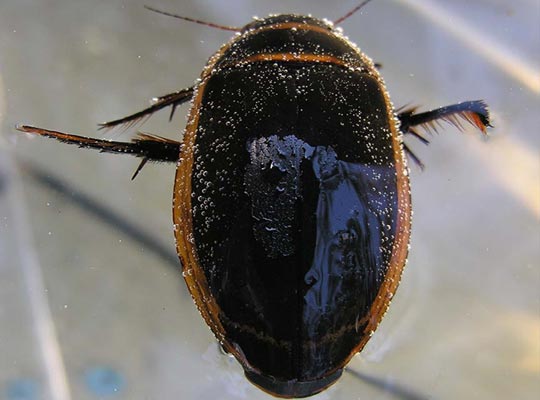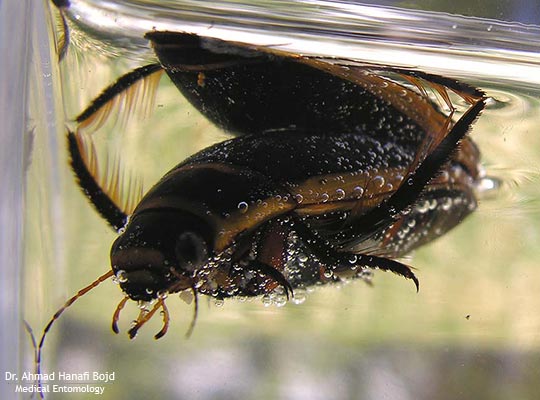Orders of Aquatic Insects
1. Collembola (Spring Tail)*--- Springs and spring ponds
2. Ephemeroptera (Mayflies)+--- Lakes and Streams
3. Odonota (Dragon and Damselflies)+--- Lakes and Streams
4. Plecoptera (Stoneflies)+ --- Streams
5. Hemiptera (True Insects) --- Lake and Stream Margins\
6. Megoloptera (Dobson and Alderflies) --- Mostly Streams
7. Neuroptera (Spongillaflies)* --- Mainly Streams- Parasitic on Sponges
8. Trichoptera (Caddisflies) --- Lakes and Streams
9. Lepidoptera (Aquatic Caterpillars of Moths)* --- Lakes and Streams
10. Coleoptera (Beetles) --- Lakes and Streams
11. Hymenoptera (Diving Wasps)* --- Terrestrial—Parasitic on Aquatic Insects
12. Diptera (Midges, Gnats, Flies, and Mosquitoes) --- All Aquatic Habitats
* -- Minor aquatic order with only a few aquatic species
+ -- Entirely aquatic orders
1.Colembola – A small group of six legged arthropods that have a specialized tail that allows them to spring from place to place. Common around vegetation and quiet edgewaters. Usually found on or near the water’s surface.
2. Ephemeroptera – Mayflies are some of the best known aquatic insects. Massive hatches are common near Lake Erie that require shovels to remove the dead carcasses from the streets. Mayflies live in both lentic (lakes) and lotic (rivers) systems, however because of their breathing mechanisms heavily silted and polluted streams and lakes are usually void of mayflies.
3. Odonata – Dragonflies and Damselflies are some of the most distinct aquatic insects. They are usually associated with vegetation and are commonly found in wetlands and backwaters of streams and lakes. They are predators of other insects and even small fishes. They are easily identified by a special mouthpart that protrudes out from their body to capture prey from a distance. The adults are beneficial because they feed on large amounts of mosquitoes.
4. Plecoptera – Stoneflies are found primarily in streams. They require a larger supply of oxygen to survive than other aquatic insects. Stoneflies can often be seen doing "pushups" after capture by humans in order to stimulate water movement along their bodies to increase oxygen flow. These insects are nearly absent from degraded and polluted streams.
5. Hemiptera – Many people may know these as water striders, commonly seen on the water surface skating quickly around. These insects are highly predacious on other insects and can put quit a toll on some species such as the larval stage of mosquitoes and other diptera. Water striders are not the only species in this order, others include the back swimmers and giant water bugs. Giant water bugs are also known as fish killers because they have been known to attack small fish and even ducklings. Others might know them as toe biters or stabbers because of what they might do to an unsuspecting bare foot while creeking.
6. Megaloptera – Smallmouth fisherman may be familiar with this order which includes hellgrammites, a ferocious looking insect that can reach 3 or more inches with giant pincher mouthparts. These are common in riffles of streams and rivers. Other alderflies are common to backwaters and areas with heavy organic matter in the water.
7. Neuroptera – Closely related to the megaloptera, this order is mainly terrestrial, however, there is a small group of aquatic species that are found only in conjunction with freshwater sponges of which these small insects feed upon. This is a very minor order.
8. Trichoptera – Caddisflies are an interesting order of insects because they build casing to hide in. They place these under and on rocks using a sticky webbing to keep tem together, some even use webs to capture food. These casings are specific to each family and many can be identified by just the casing because of the shape or type of material used in construction.
9. Lepidoptera - Most butterfly and moth larvae are terrestrial; however there are a few that have an aquatic larval stage. These caterpillars are closely related to vegetation in the water, from which they feed upon. Some aquatic caterpillars are harmful to rice patties and water lilies, however some may have potential to be biological controls for invasive or pest aquatic plants.
10. Coleoptera - Beetles are one of the most diverse order of aquatic insects. Some only have larval stages in the water, while others also live in the water as adults. Some may know one family as whirligig beetles, the little round bugs one sees spinning around in circles on the surface of the water. There are also water pennies that are found stuck to rocks that resemble a small flat circle crawling around amongst the algae. Beetles can be found in all aquatic habitats.
11. Hymenoptera - Hymenoptera includes terrestrial species such as ants, bees and wasps. There are a few wasps, however, that are parasitic to aquatic species and therefore dive underwater to lay their eggs. Some families lay their eggs in midges or water pennies, others lay their eggs in fishing spiders. As the larvae develop they eat the parasitized individual for nourishment.
12. Diptera - The true flies are found in every aquatic habitat imaginable from water left in an abandoned tire to the most pristine mountain stream, from the depths of a lake to the riffles of a stream, brackish to fresh water they all contain fly larvae. The best known fly larvae would be that of mosquitoes, however, one of the most important larvae ecologically are that of midges. Many may feed these to their fish known as blood worms. Blood worms are the favorite food of yellow perch, trout, darters and many other fish species.

سوسک های آبزی:
سوسکهای شیرجه زن (خانواده Dytiscidae)
بهاره ها (Mayflies)
سنجاقک ها (Odonata: Damselflies)
آسیابک ها (Odonata: Dragonflies)
ساسهای آبزی (Aquatic Hemiptera)
خانواده Blastomatidae
خانواده Gerridae
خانواده Corixidae
خانواده Nepidae
خانواده Hydrometridae
خانواده Notonectidae
دوبالان آبزی (Aquatic Diptera)
خانواده کولیسیده
خانواده تابانیده
خانواده کایرونومیده
خانواده تیپولیده
خانواده Stratiomyidae یا Soldier fly
خانواده Syrphidae
خانواده Simuliidae یا Blackflies
راسته Trichoptera یا Caddisflies
سس
برای دریافت اطلاعات بیشتر در مورد حشرات آبزی می توانید به این وبلاگ سری بزنید:
http://www.dnr.state.md.us/bay/cblife/insects/index.html


